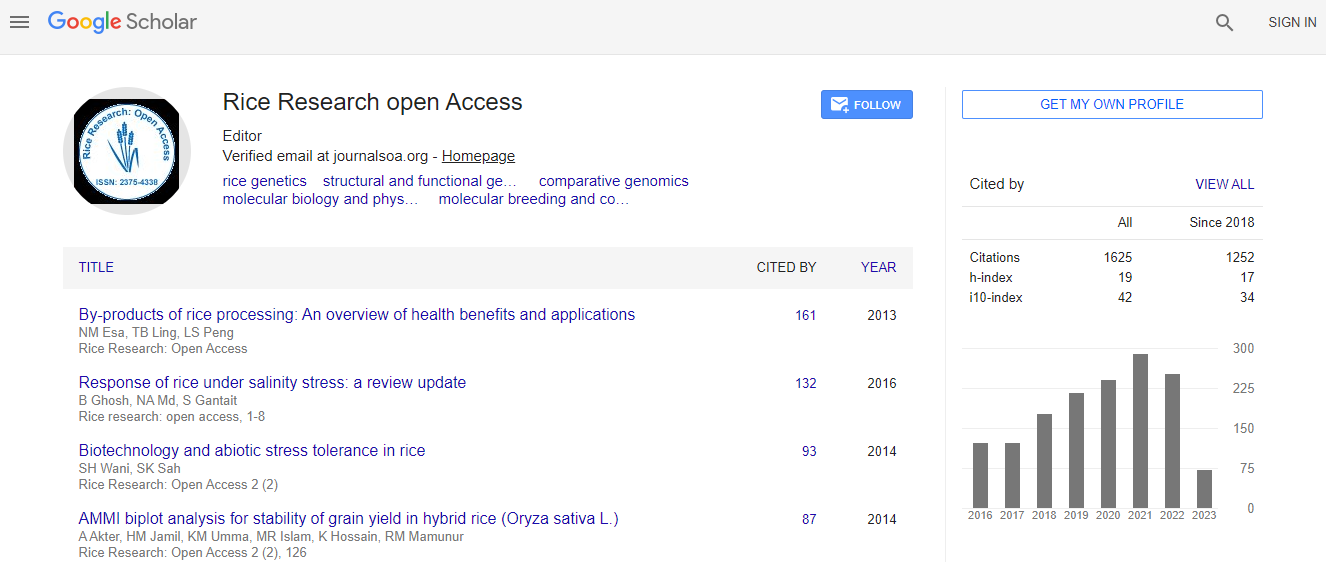Research Article
Effect of Salinity and Potassium Levels on Different Morpho-Physiological Characters of two Soybean (Glycine max L.) Genotypese
| Hashi US1, Karim A2, Saikat HM2, Islam R2and Islam MA3* | |
| 1EXIM Bank Agricultural University, Bangladesh | |
| 2Bangabandhu Sheikh Mujibur Rahman Agricultural University, Bangladesh | |
| 3Department of Genetics and Plant Breeding, EXIM Bank Agricultural University, Bangladesh | |
| Corresponding Author : | Dr. Md. Ariful Islam Department of Genetics and Plant Breeding EXIM Bank Agricultural University Bangladesh Tel: +88-01711872774 E-mail: i.aarif@yahoo.com |
| Received: March 25, 2015 Accepted: July 04, 2015 Published: July 09, 2015 | |
| Citation:Hashi US, Karim A, Saikat HM, Islam R, Islam MA (2015) Effect of Salinity and Potassium Levels on Different Morpho-Physiological Characters of two Soybean (Glycine max L.) Genotypes. J Rice Res 3: 143. doi:10.4172/2375- 4338.1000143 | |
| Copyright: ©2015 Hashi US, et al. This is an open-access article distributed under the terms of the Creative Commons Attribution License, which permits unrestricted use, distribution, and reproduction in any medium, provided the original author and source are credited | |
| Related article at Pubmed, Scholar Google | |
Abstract
A field experiment was conducted in the field of Department of Agronomy of Bangabandhu Sheikh Mujibur Rahman Agricultural University, Gazipur, Bangladesh to assess the effect of potassium on different mineral ions accumulation pattern in leaves of salt affected soybean and to draw the relationship between the dry matter production and mineral ions accumulation in leaves for better understanding the effect of potassium in mitigating salinity stress. The plant height decreased with the increase in salinity levels. In general, Galarsum (V1 ) was taller than Bangladesh Soybean-4 (V2 ) at all levels of salinity. Potassium in general increased relative plant height under salinity. Galarsum with K2 (119.52 kg/ha) potassium showed relatively higher plant height at mild salinity, though at the high level of salinity the plant height increased with the higher level of potassium. The minimum relative plant height of Galarsum was obtained at the highest salinity with no potassium fertilizer. Application of different levels of K increased the production of relative stem dry weight at both 5 dS/cm (S1 ) and 7.5 dS/cm (S2 ) levels of the salinity compared to the control (S0 ). At 5 dS salinity the relative stem DW in Galarsum ranged from 46 to 66% and that at 7.5 dS salinity from 35 to 40%. Whereas, in Bangladesh Soybean-4 the stem DW ranged from 58 to 75% at S1 and that from 34 to 52% at S2 level of salinity. Therefore, the percent reduction in stem DW due to salinity was more in V2 than V1 when salinity increased from S1 to S2 under K0 and K1 potassium treatments. Moreover, the positive effect of K on the production of relative stems DW under different level of salinity. Irrespective of K levels salinity decreased the leaf dry weight in both the genotypes and the reduction in leaf DW increased with the increasing of salinity levels. The leaf DW of Galarsum (V1 ) was much higher than that of Bangladesh Soybean-4 at all level of salinity and potassium. At the control (S0 ) the increasing levels of K application decreased the leaf DW production in V1 , though in V2 the weight increased substantially. The relative leaf DW of two soybean genotypes increased with increasing K application in each salinity level except S1 K2 , S2 K3 treatments of V1 . Bangladesh Soybean-4 showed higher negative relationship (y=-40.89x+17.92, R2 =0.80) than Galarsum (y=-46.96x+24.22, R2 =0.74) between Na:Ca ratio and total dry weight. The R2 value indicates that about 73% of the contribution to the TDW of V1 and 80% of V2 can be explained by the Na:Ca ratio. TDW decreased with increasing Na:Ca ratio concentration in leaves of two soybean genotypes.

 Spanish
Spanish  Chinese
Chinese  Russian
Russian  German
German  French
French  Japanese
Japanese  Portuguese
Portuguese  Hindi
Hindi 
